All-Volunteer Force Still ‘Best Model’ for US Military
All-Volunteer Force Still ‘Best Model’ for US Military

Fifty years on, and facing a tough recruiting environment, a professional, all-volunteer force remains “the best model” for the U.S. military, Deputy Defense Secretary Kathleen Hicks said.
Speaking at the Center for a New American Security, Hicks said that when the U.S. shifted to an all-volunteer force 50 years ago, “success was not a given.”
“Moving from conscripts to relying exclusively on volunteers to raise their hand and make a commitment to military service was a new ballgame,” Hicks said.
To make it work, the U.S. professionalized the force, incentivized volunteers with the “promise of good pay, benefits and family support, and ensuring that our value proposition remained a worthwhile one over the years.”
“That our all-volunteer force has lasted for 50 years, and that we have built the finest force in the world, is a testament to its strength,” Hicks said. But, she added,” we cannot take it for granted, and we must address and attend to its challenges.”
Among those challenges are ensuring healthy civilian-military relations and recruiting and retaining the force needed to defend the country, she said.
“We must ensure that as a society, we are familiar with the military, with military families and what they do and the sacrifices that they make for the nation,” Hicks said. “For years, Americans’ trust and confidence in our institutions … has been on decline. The military remains one of our nation’s most trusted institutions, and we'd like to keep it that way.”
Recruiting is another challenge for the military, Hicks said. “Since the COVID-19 pandemic and amid a hot job market with the lowest unemployment rate in 50 years, military recruitment has been a challenge, and we’ve been hard at work recovering.”
Each of the services has been “working tirelessly” on recruiting, she said, adding bonuses and incentives, making policy changes and standing up new programs.
But the military also needs society’s help. “As the veteran population has gone from 18% of American adults in 1980 to less than 7% in 2022, it has reduced most Americans’ familiarity with the military,” Hicks said. “This means fewer Americans have direct ties to a family member, a friend or neighbor who served, and without those direct ties, it is harder to observe the military way of life up close.”
While the military must increase its community outreach and continue to tell its story, the nation must amplify the value and importance of service, Hicks said.
“This change in military recruitment patterns didn't happen overnight,” she said. “It’s generational, and it is our responsibility to tell younger generations the benefits of military service, of the educational benefits and the cutting-edge training that they can receive, and the skills they can learn and develop, of the financial benefits and the family support, and of the opportunities to lead and work toward a common purpose.”
Amid these challenges, one piece of good news is retention is strong, Hicks said.
“While we are not a perfect institution, we are sending a strong signal that we’re listening and we’re moving to make progress wherever we can for those who currently serve, and to be more attractive to those who show a propensity to serve,” she said.

